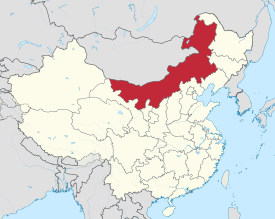
Back Mongolia Dalam ACE Binne-Mongolië Afrikaans منغوليا الداخلية Arabic Mongolia Interior AST Daxili Monqolustan Muxtar Rayonu Azerbaijani داخیلی موغولیستان AZB Innare Mongolei BAR Унутраная Манголія Byelorussian Унутраная Манголія BE-X-OLD Вътрешна Монголия Bulgarian
Inner Mongolia | |
|---|---|
| Inner Mongolia Autonomous Region | |
| Name transcription(s) | |
| • Chinese | 内蒙古自治区 (Nèi Měnggǔ Zìzhìqū) |
| • Mongolian | ᠥᠪᠥᠷ ᠮᠣᠩᠭᠣᠯ ᠤᠨᠥᠪᠡᠷᠲᠡᠭᠨ ᠵᠠᠰᠠᠬᠤ ᠣᠷᠣᠨ(Öbür mongγol-un öbertegen jasaqu orun) |
| • Abbreviation | NM / 蒙 (Měng) |
Clockwise from the top left:
| |
 Location of Inner Mongolia within China | |
| Coordinates: 44°N 113°E / 44°N 113°E | |
| Country | China |
| Capital | Hohhot |
| Largest city | Baotou |
| Divisions - Prefecture-level - County-level - Township- level | 12 prefectures 103 counties 1025 towns and subdistricts |
| Government | |
| • Type | Autonomous region |
| • Body | Inner Mongolia Autonomous Regional People's Congress |
| • CCP Secretary | Sun Shaocheng |
| • Congress Chairman | Sun Shaocheng |
| • Government Chairwoman | Wang Lixia |
| • Regional CPPCC Chairman | Zhang Yankun |
| • National People's Congress Representation | 58 deputies |
| Area | |
| • Total | 1,183,000 km2 (457,000 sq mi) |
| • Rank | 3rd |
| Highest elevation (Main Peak, Helan Mountains[2]) | 3,556 m (11,667 ft) |
| Population (2020)[3] | |
| • Total | 24,049,155 |
| • Rank | 25th |
| • Density | 20/km2 (53/sq mi) |
| • Rank | 28th |
| Demographics | |
| • Ethnic composition | Han – 78.7% Mongol – 17.7% Others – 3.6% |
| • Languages and dialects | Mandarin Chinese, Mongolian, Oirat, Buryat, Dagur, Evenki, Jin[4] |
| GDP[5] | |
| • Total | CN¥ 2.316 trillion US$ 344 billion |
| • Per capita | CN¥ 96,474 US$ 14,343 |
| ISO 3166 code | CN-NM |
| HDI (2021) | 0.777[6] (8th) – high |
| Website | www Mongol version |
Inner Mongolia,[a] officially the Inner Mongolia Autonomous Region,[b] is an autonomous region of the People's Republic of China. Its border includes two-thirds of the length of China's border with the country of Mongolia. Inner Mongolia also accounts for a small section of China's border with Russia (Zabaykalsky Krai). Its capital is Hohhot; other major cities include Baotou, Chifeng, Tongliao, and Ordos.
The autonomous region was established in 1947, incorporating the areas of the former Republic of China provinces of Suiyuan, Chahar, Rehe, Liaobei, and Xing'an, along with the northern parts of Gansu and Ningxia.
Its area makes it the third largest Chinese administrative subdivision, constituting approximately 1,200,000 km2 (463,000 sq mi) and 12% of China's total land area. Due to its long span from east to west, Inner Mongolia is geographically divided into eastern and western divisions. The eastern division is often included in Northeastern China (Dongbei), with major cities including Tongliao, Chifeng, Hailar, and Ulanhot. The western division is included in North China, with major cities including Baotou and Hohhot. It recorded a population of 24,706,321 in the 2010 census, accounting for 1.84% of Mainland China's total population. Inner Mongolia is the country's 23rd most populous province-level division.[7] Han Chinese make up the majority of the population in the region; Mongols constitute a significant minority with over 4 million people,[8] making it the largest Mongol population in the world (larger than that of the country Mongolia).[9] Inner Mongolia is one of the more economically developed provinces in China with annual GDP per capita at US$14,343 (2022), ranked 8th in the nation. The official languages are Mandarin and Mongolian, the latter of which is written in the traditional Mongolian script, as opposed to the Mongolian Cyrillic alphabet, which is used in the country of Mongolia (formerly often described as Outer Mongolia).
- ^ "Doing Business in China – Survey". Ministry Of Commerce – People's Republic Of China. Archived from the original on 5 August 2013. Retrieved 5 August 2013.
- ^ Cite error: The named reference
quaternarywas invoked but never defined (see the help page). - ^ "Communiqué of the Seventh National Population Census (No. 3)". National Bureau of Statistics of China. 11 May 2021. Retrieved 11 May 2021.
- ^ "China". Ethnologue.
- ^ "National Data". National Bureau of Statistics of China. 1 March 2022. Retrieved 23 March 2022.
- ^ "Subnational Human Development Index". Global Data Lab China. 2021. Retrieved 9 April 2020.
- ^ "Tabulation on the 2010 Population Census of the People's Republic of China". stats.gov.cn. Archived from the original on 7 July 2013. Retrieved 7 May 2013.
- ^ Cite error: The named reference
Ethnicitywas invoked but never defined (see the help page). - ^ "China's push to create a single national identity". The Economist. 14 September 2023.
Cite error: There are <ref group=lower-alpha> tags or {{efn}} templates on this page, but the references will not show without a {{reflist|group=lower-alpha}} template or {{notelist}} template (see the help page).
© MMXXIII Rich X Search. We shall prevail. All rights reserved. Rich X Search





